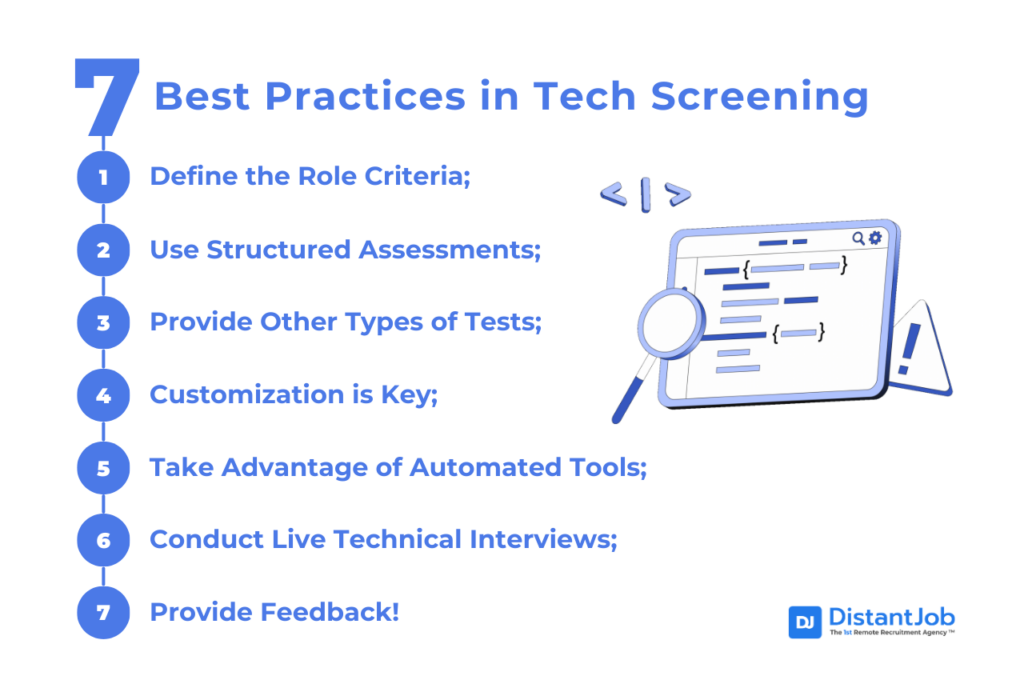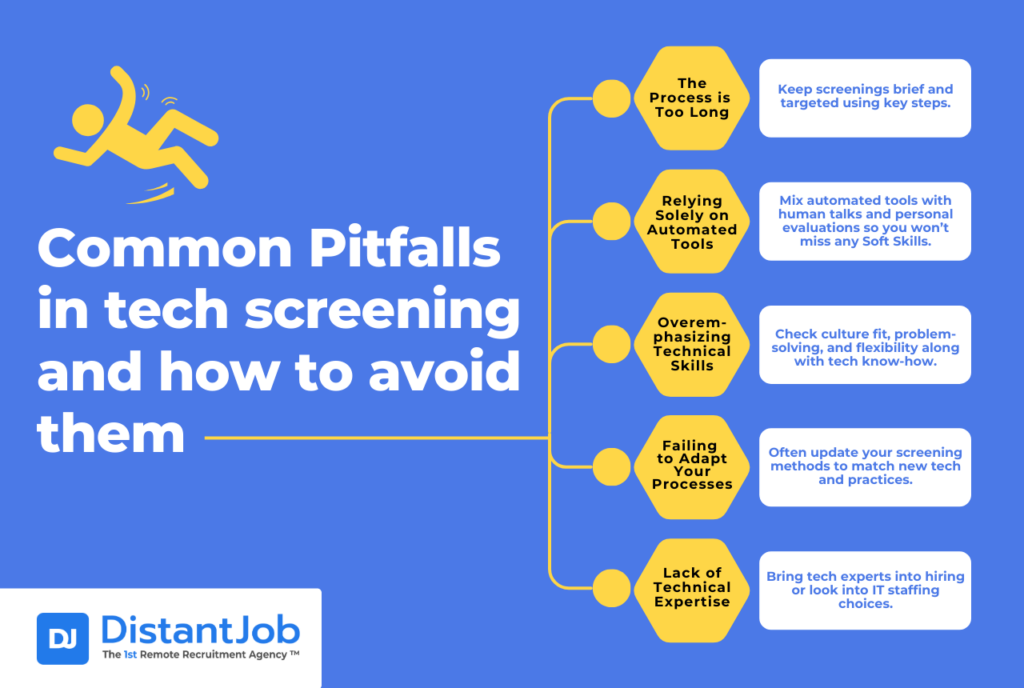Technical screening plays a key role in figuring out if a job seeker has what it takes to do well in a specific position. This focused process aims to evaluate a candidate’s skills making sure they meet the main requirements before moving on to more detailed interviews.
Look, we all know the tech hiring game is tough. You’re not just looking for someone who can rattle off a list of programming languages. You want the real deal – senior developers who can solve complex problems, explain tricky concepts, and actually get excited about the tech they’re working with.
The problem is that the best ones, usually are already employed. And it takes an average of 27 days to fill an IT job in the U.S. That’s almost a month of lost productivity! That’s where smart technical screening comes in. It’s not just a filter – it’s a tool to identify exceptional candidates efficiently, even those who aren’t actively job hunting.
For job seekers, understanding the technical screening process is also invaluable. It allows for better preparation and more effective showcasing of skills during the hiring process.
Our guide will help you improve your technical screening process, from avoiding common pitfalls to utilizing efficiency-boosting tools. You’ll learn how to balance technical skills with cultural fit and prepare for remote hiring, ultimately bringing top talent onto your team.
What is Technical Screening?
Technical screening is the process by which companies evaluate a candidate’s technical skills, knowledge, and problem-solving abilities before moving forward with more intensive interviews or practical assessments. In essence, technical screening helps employers filter out candidates who don’t meet the basic technical requirements for a role, saving time and resources in the long run. This process can take various forms, from online coding tests and technical questionnaires to brief phone interviews with a technical team member.
Common ways to screen candidates include coding tests looking at portfolios, and technical chats. These methods help spot how well someone can tackle real-world problems, work with relevant tech, and fit into the fast-moving world of a tech team.
In today’s tough market where time matters and remote teams are becoming common, a well-tuned technical screening process makes sure the best candidates move forward. By using a smoother approach, you can trim down extra steps and bring the right talent on board quicker helping your team stay productive and on track.
Is Technical Screening the same as the Technical Interview?
The difference between them is that while technical screening shrinks the group of candidates, screening interviews help figure out who’s the right match for the job.
Technical screening acts as the first hurdle to check a candidate’s basic tech skills. It’s a faster, more automated step that includes coding tasks, homework assignments, or short video calls to verify a candidate’s core knowledge.
On the other hand, a technical interview digs deeper and zeros in on tricky problem-solving, system design, and how well a candidate can handle real-world projects. These interviews last longer and often involve coding on whiteboards or coding together to assess a candidate’s advanced tech skills and how well they’d fit in with the team.
Why Should You Screen Test Your Tech Candidates
Screen testing your tech candidates is essential for making better hiring decisions based on real skills. Instead of relying on resumes or interviews alone, technical tests give you solid data to compare candidates.
This process saves time by filtering out unqualified applicants early, allowing your team to focus on those who actually meet the job requirements. It also improves the overall quality of your hires and helps reduce turnover by ensuring you bring on people who are not only skilled but also a good long-term fit for your company.
7 Best Practices in Tech Screening

There are different methods for conducting a technical screening process. In most cases, recruiters focus on phone screenings and code assessments. While both approaches are suitable to evaluate technical skills, they are not the only ones to ensure a holistic evaluation.
Let’s go over the best practices that will help you craft your tech screenings based on the roles you’re looking for.
1. Define the Role Criteria
While basic, this first step sets the foundation for a successful hiring process. Knowing you’re looking to hire a developer is not the same as knowing you’re looking for a mobile app developer with extensive experience in building cross-platform applications.
Not all projects are the same and require the same level of knowledge. The level of specialization varies, particularly for tech roles.
Start by establishing clear and specific criteria for technical proficiency relevant to the role. Here is where you define what are the “Non-negotiables” in terms of skills, technologies and experience required, ensuring that this first screening filters all these candidates, separating the good ones from the great ones.
When setting up criteria, make sure you think about how well the candidate can adapt to working remotely. Someone who does well working from home might have different strengths than a person who’s better suited for office work. For example, they might be better at managing themselves and communicating with others.
2. Use Structured Assessments
Tech screening focuses mostly on filtering the first batch of candidates. Ideally, a good screening test is able to separate candidates so you can then focus on more thorough technical interviews based on the roles you’re seeking.
With structured assessments, you can have a good grasp of a candidate’s technical abilities. Based on the role you’re looking for, coding challenges, problem-solving experiences, or technical quizzes can be designed to gauge proficiency in relevant areas. Usually, these assessments are divided into two parts:
- Pre-interview online tests: Some companies, particularly those that have a large number of applicants, use online multiple-choice tests or coding exercises to narrow the candidate pool. Usually, these tests take less than an hour and are very straightforward.
- Interview screening: In this first interview you can ask candidates general background questions regarding their education and work experience.
Another way to bring in structure involves using real-life situations that match the hurdles the applicant will encounter in the job. This makes sure you evaluate their technical abilities and how they put those skills to use in practice.
3. Be Flexible Providing Other Types of Tests
The problem with pre-interview online tests is that while they are often used to reduce the talent pool by only selecting a few candidates for more in-depth interviews, they usually don’t accurately reflect a candidate’s true capabilities or potential.
We’ve noticed that in some cases, skilled candidates may not perform that well in those types of tests for different reasons. In some cases, they are better equipped to excel in practical, real-life scenarios; in others, they are unfamiliar with testing platforms, etc.
You can also be flexible and provide other types of evaluation methods. A blend of assessments has usually worked great for us.
Again, this depends on the role. However, some additional tests that are useful for filtering out candidates are take-at-home evaluations and a pair programming interview.
Take-at-home evaluations allow candidates to showcase their skills within a specific timeframe in their own environment. Without the pressure of a timed assessment, they can provide a more accurate reflection of their capabilities.
On the other hand, pair programming interviews are highly effective for roles that require collaboration and teamwork. During these interviews, candidates work with current team members to solve coding challenges or real-world problems synchronously. This approach allows you to evaluate candidates’ technical skills and their ability to communicate, collaborate and adapt to different working styles.
Additionally, when it comes to hiring remote workers, being flexible is key. Think about using async coding tests. This allows programmers to finish tasks when it suits them best. As a result, you’re more likely to see their top-notch work rather than how they handle pressure.
4. Customization is Key
Each role requires a different skill set. To ensure that your tech screening is effective, you need to customize it based on your criteria and hiring needs.
For example, a software engineering position may prioritize proficiency in programming languages, algorithmic problem-solving, and familiarity with certain development frameworks. In contrast, a data science role might emphasize expertise in statistical analysis and machine learning algorithms.
By customizing the screening process to focus on these role-specific competencies, you can create a more reliable filter for evaluating a candidate’s qualifications.
You can have foundational tests and change them based on the role. For example, a first live interview to get to know the candidate better, an online test, and a take-at-home test. Based on those results, you can choose whether to move forward with the candidate or continue looking for other candidates.
Also, consider adjusting these assessments to fit remote settings as they can shed light on how a candidate will work in a distributed team. For example, using shared coding platforms that mimic collaboration across different time zones can provide valuable insights.
5. Take Advantage of Automated Tools
Using automated tools and platforms can help streamline the screening process even more. These tools are particularly useful for coding and technical assessments. They can help you evaluate code submissions and gain more insights into candidates’ performance.
Here are some useful screening tools to vet tech candidates:
| Category | Tools |
| Online Coding Platforms | HackeRank, LeetCode, CodeSignal |
| Technical Assessment Platforms | Codility, TestDome, CoderPad |
| Take-home Assignments | GitHub, GitLab, Bitbucket |
| Pair Programming Interviews | CodePen, Collabedit, Live Share |
| Behavioral Assessment Tools | Pymetrics, Traitify |
Although these tools handle a lot of the technical screening, people’s input should still be involved when evaluating teamwork and interaction—which are important in remote jobs.
6. Conduct Live Technical Interviews
Live technical interviews are an important part of the tech screening process as they allow you to grasp more about the candidate’s technical skills and knowledge.
Besides coding tests or solving coding challenges, live interviews allow you to discuss technical concepts, which allows you to see how well-versed a candidate is in specific technologies and programming languages. You can also evaluate, through their answers, their ability to explain technical concepts.
For remote team building, video interviews that use whiteboarding tools or shared coding platforms help recreate an in-office technical interview experience. This approach allows you to fully assess how well candidates communicate and solve problems.
7. Provide Feedback
Providing feedback to candidates is another aspect of technical screening that is often forgotten. Candidates take time and effort in the interviewing process, so rather than just ghosting them or saying they are not moving forward, you can enhance the candidate experience by giving brief feedback on why they were not selected.
Candidate experience says a lot about your company. If candidates have an unpleasant experience, they will likely share it. 22% of unhappy candidates will actively encourage others to avoid applying to your company. And about 72% will share their experience online, which can impact your brand’s online reputation.
This back-and-forth feedback process also works for remote hiring. When you give clear and helpful feedback even in a remote setup, it helps keep your company’s image positive and makes candidates more interested in working with you.
Common Pitfalls in Technical Screening (and How to Avoid Them)
When you’re doing tech screenings, it’s easy to get stuck in ways that can slow down hiring or lead to picking the wrong people. By spotting and fixing these common problems, you can speed up your hunt for talent and make sure you’re bringing the right folks on board.
Here’s a look at the usual hiccups in tech screening and some down-to-earth fixes to get past them:

By tackling these problems, you’ll make your technical screening better and boost your odds of finding great candidates.
Essential Technical Screening Questions
A good technical screening process does more than just check coding skills; it looks at a candidate’s overall technical abilities, how they solve problems, and their grasp of key ideas.
Here are some main areas to focus on when creating technical screening questions:
Programming Language Proficiency
To see how well a candidate knows the programming languages your team uses, ask questions that test their understanding of basic programming ideas and simple coding tasks. This can give you a clear picture of how good they are with the language your company needs.
Examples:
- “Create a Python function to flip a string.”
- “How do functional and object-oriented programming differ?”
- “Compare asynchronous and synchronous programming approaches.”
To get more specific insights, check out our Python interview questions or PHP interview questions for extra help in crafting your technical evaluations.
Problem-Solving Skills
Any tech job needs problem-solving skills, and technical screening questions should show this. These questions evaluate how candidates tackle challenges and think when under pressure.
Examples:
- “Tell me about the main parts of an algorithm.”
- “If your code gives an error, how do you fix it?”
- “What would you do to speed up a system that’s running?”
These questions show technical skills and give you a peek into how the candidate solves problems and uses what they know.
System Design and Architecture (Entry-Level)
When it comes to more complex jobs or applicants seeking roles that need design expertise, it’s useful to include small-scale system design questions. While in-depth architecture talks might be saved for subsequent interviews, screening questions can still evaluate their grasp of fundamental design concepts.
Examples:
- “How would you create a basic URL shortening service?”
- “Can you describe what RESTful APIs are and how people use them?”
- “What sets monolithic architecture apart from microservices architecture?”
These questions give you insight into how well the candidate grasps essential architecture ideas, which play a crucial role in scaling and keeping systems reliable.
Knowledge of Tools and Methods
It’s crucial to know how comfortable the candidate is with key tools and methods to make sure they fit with your team’s way of working. Questions about software development practices, cloud tech, and infrastructure will help you figure out if the candidate can work well with your tech setup.
Examples:
- “What tech stack do you know best, and how have you used it in your previous work?”
- “Have you worked with cloud platforms like AWS or Microsoft Azure? If yes, tell us about a project where you used these services.”
- “What project management method do you like most, and why? How have you used it in your past jobs?”
To learn more, take a look at our React JS interview questions or C# interview questions.
Real-World Problem Solving
To recreate real-world situations, ask job seekers how they’d deal with actual problems or mention specific experiences. Questions about solving real-world issues give you a glimpse into how they put their know-how to use in everyday cases.
Examples:
- “Share a time when you fixed a big performance problem. What steps did you take?”
- “If you had to make an API work better with more traffic, what would you do?”
- “Tell us about a time you worked with others to solve a critical issue. How did you make sure it turned out well?”
When you customize your technical screening questions to match your company’s requirements, you assess the candidate’s technical skills and get a better idea of how they handle tasks, fix problems, and work with others. To get more insights on entry-level jobs, you can check out our entry-level Java developer interview questions or software developer interview questions.
By mixing these groups, you’ll build a more dependable screening method that quickly spots the best-qualified candidates to evaluate further.
Conclusion
In sum, a good technical screening process goes beyond finding someone who knows how to code. It’s about ensuring your candidates fit your company’s specific requirements—both in terms of skills and culture. When you use best practices like structured tests, adaptable evaluations, and real-world problem-solving tasks, you boost your chances of hiring the right people quicker and with fewer mistakes.
Remember to continuously refine your screening process. Take feedback into account, adapt to new tech, and keep an eye on industry shifts. This method not only saves time but also improves the quality of your hires helping you create a stronger, more resilient team.
Also keep in mind that tech screening processes involve aspects like having qualified IT recruiters and headhunters and the technology and experience to conduct these interviews.
With our 3-Tier Approval Process (TAP), we’re able to deliver meticulously vetted candidates, starting from detailed client needs assessment through strategic talent sourcing and candidate review. With our method, we ensure that you’ll have the perfect match not only for technical skills but also for company culture.
Find out more about our approach by booking a discovery call.




